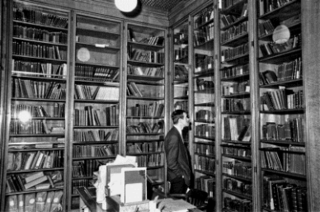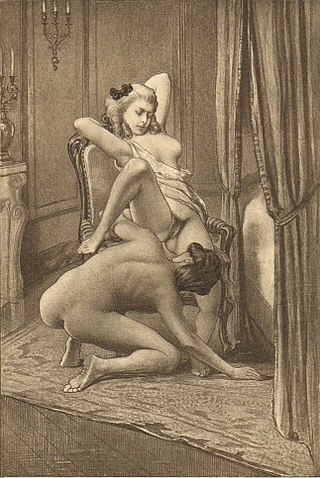Related Research Articles
The role of sadism and masochism in fiction has attracted serious scholarly attention. Anthony Storr has commented that the volume of sadomasochist pornography shows that sadomasochistic interest is widespread in Western society; John Kucich has noted the importance of masochism in late-19th-century British colonial fiction. This article presents appearances of sadomasochism in literature and works of fiction in the various media.
Theresa Berkley or Berkeley was a 19th-century English dominatrix who ran a brothel in Hallam Street, just to the east of Portland Place, Marylebone, London, specialising in flagellation. She is notable as the inventor of the "chevalet" or "Berkley Horse", a BDSM apparatus.

Henry Spencer Ashbee was a book collector, writer and bibliographer. He is notable for his massive, clandestine three-volume bibliography of erotic literature published under the pseudonym of Pisanus Fraxi.

The Pearl: A Magazine of Facetiae and Voluptuous Reading was a pornographic monthly magazine issued in London during the mid-Victorian period by William Lazenby. It was closed down by the British authorities for violating contemporary standards of obscenity.
Rosa Coote is a fictional dominatrix appearing as a stock character in a number of works of Victorian erotica, including The Convent School, or Early Experiences of A Young Flagellant by William Dugdale and "Letters to a Lady Friend" or "Miss Coote's Confession" in The Pearl. Henry Spencer Ashbee writes of The Convent School that "The book is not altogether badly written; no part of the narrative however is attractive".
William Simpson Potter was a 19th-century English author. Potter was a friend of Henry Spencer Ashbee, a merchant, bibliographer, bibliophile, authority on the life and works of Miguel de Cervantes, and collector of erotic materials. Ashbee describes Potter as a "shrewd business man, the ardent collector, and the enthusiastic traveller".
The Romance of Lust, or Early Experiences is a Victorian erotic novel written anonymously in four volumes during the years 1873–1876 and published by William Lazenby. Henry Spencer Ashbee discusses this novel in one of his bibliographies of erotic literature. In addition the compilers of British Museum General Catalogue of Printed Books list this book.

My Secret Life, by "Walter", is the memoir of a gentleman describing the author's sexual development and experiences in Victorian England. It was first published in a private edition of eleven volumes, at the expense of the author, including an imperfect index, which appeared over seven years beginning around 1888.
The Sins of the Cities of the Plain; or, The Recollections of a Mary-Ann, with Short Essays on Sodomy and Tribadism, by the pseudonymous "Jack Saul", is one of the first exclusively homosexual works of pornographic literature published in English. The book was first published in 1881 by William Lazenby, who printed 250 copies. A second edition was published by Leonard Smithers in 1902. It sold for an expensive four guineas.
William Dugdale was an English publisher, printer, and bookseller of politically subversive publications and pornographic literature in England during the 19th century. By the 1850s he had become "the principal source of such publications in the country". Despite the numerous police raids on his shops and spending many years in prison he remained in the book trade for over forty years.
Edward Sellon (1818–1866) was an English writer, translator, and illustrator of erotic literature.

The Mysteries of Verbena House, or, Miss Bellasis Birched for Thieving is a pornographic novel of flagellation erotica set in a girls' school, written under the pseudonym Etonensis by George Augustus Sala and completed by James Campbell Reddie. It was published in 1882 in a limited edition of 150 copies at the price of 4 guineas.
James Campbell Reddie was a 19th-century British solicitor, collector and author of pornography, who, writing as "James Campbell", worked for the publisher William Dugdale. According to Henry Spencer Ashbee, Reddie was self-taught and viewed his works from a philosophical point of view.

The Private Case is a collection of erotica and pornography held initially by the British Museum and then, from 1973, by the British Library. The collection began between 1836 and 1870 and grew from the receipt of books from legal deposit, from the acquisition of bequests and, in some cases, from requests made to the police following their seizures of obscene material.
The Library Illustrative of Social Progress was a series of pornographic books published by John Camden Hotten around 1872. They were mainly reprints of eighteenth-century pornographic works on flagellation. Hotten claimed to have found them in the library of Henry Thomas Buckle (1821–1862) but Henry Spencer Ashbee counterclaimed that they were in fact from his collection.
Experimental Lecture is an English pornographic book published in 1878 by the pseudonym "Colonel Spanker" for the "Cosmopolitan Society of Bibliophiles", an imprint of Charles Carrington. The Colonel and his circle have a house in Park Lane where genteel young ladies are kidnapped, humiliated, and flagellated.
The Victim of Lust, or Scenes in the Life of Rosa Fielding is an anonymously written Victorian pornographic novel published by William Dugdale in 1867.

Victorian erotica is a genre of sexual art and literature which emerged in the Victorian era of 19th-century Britain. Victorian erotica emerged as a product of a Victorian sexual culture. The Victorian era was characterized by paradox of rigid morality and anti-sensualism, but also by an obsession with sex. Sex was a main social topic, with progressive and enlightened thought pushing for sexual restriction and repression. Overpopulation was a societal concern for the Victorians, thought to be the cause of famine, disease, and war. To curb the threats of overpopulation and to solve other social issues that were arising at the time, sex was socially regulated and controlled. New sexual categories emerged as a response, defining normal and abnormal sex. Heterosexual sex between married couples became the only form of sex socially and morally permissible. Sexual pleasure and desire beyond heterosexual marriage was labelled as deviant, considered to be sinful and sinister. Such deviant forms included masturbation, homosexuality, prostitution and pornography. Procreation was the primary goal of sex, removing it from the public, and placing it in the domestic. Yet, Victorian anti-sexual attitudes were contradictory of genuine Victorian life, with sex underlying much of the cultural practice. Sex was simultaneously repressed and proliferated. Sex was featured in medical manuals such as The Sexual Impulse by Havelock Ellis and Functions and Disorders of Reproductive Organs by William Acton, and in cultural magazines like The Penny Magazine and The Rambler. Sex was popular in entertainment, with much of Victorian theatre, art and literature including and expressing sexual and sensual themes.
The Modern Rake is an anonymous erotic novel with nine coloured illustrations which was printed at London by J. Sudbury in 1824. The title page describes the plot: The Modern Rake; or, the Life and Adventures of Sir Edward Walford: Containing a Curious and Voluptuous History of his luscious intrigues, with numerous women of fashion, his laughable faux pas, feats of gallantry, debauchery, dissipation, and concubinism! His numerous rapes, seductions, and amatory scrapes. Memoirs of the Beautiful Courtezans with whom he lived; with some Ticklish Songs, Anecdotes, Poetry, &c. Enriched with many Curious Plates.

Erotic fiction is a part of erotic literature and a genre of fiction that portrays sex or sexual themes, generally in a more literary or serious way than the fiction seen in pornographic magazines. It sometimes includes elements of satire or social criticism. Such works have frequently been banned by the government or religious authorities. Non-fictional works that portray sex or sexual themes may contain fictional elements. Calling an erotic book 'a memoir' is a literary device that is common in this genre. For reasons similar to those that make pseudonyms both commonplace and often deviously set up, the boundary between fiction and non-fiction is broad.
References
- ↑ Donald Eugene Hall, Maria Pramaggiore, "Representing bisexualities: subjects and cultures of fluid desire", NYU Press, 1996, ISBN 0-8147-6634-X, pp.110-111
- ↑ Steven Marcus, "The other Victorians: a study of sexuality and pornography in mid-nineteenth-century England", Transaction Publishers, 2009, ISBN 1-4128-0819-7, p.74
- ↑ Iain McCalman, "Radical underworld: prophets, revolutionaries, and pornographers in London, 1795-1840", CUP Archive, 1988, ISBN 0-521-30755-4, pp.209-210
- ↑ Pisanus Fraxi [Henry Spencer Ashbee], "Catena librorum tacendorum", 1885, p.314
- ↑ Henry Spencer Ashbee (1969) Index of Forbidden Books. London, Sphere: 321
- ↑ Phyllis and Eberhard Kronhausen (1969) Erotic Fantasies: A Study of the Sexual Imagination. New York, Grove Press: 278-85